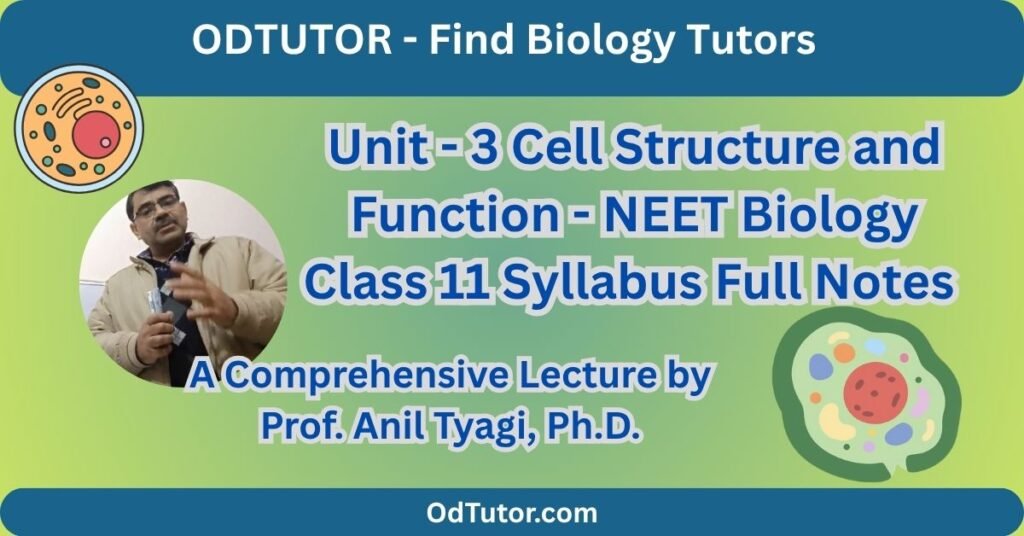My dear NEET aspirants! This is Professor Anil Tyagi. Welcome to a cornerstone of your NEET preparation—Unit 3: Cell Structure and Function. This unit is not just a collection of facts; it is the story of life itself at its most fundamental level. A strong command here lays the groundwork for genetics, physiology, and biotechnology. I will now guide you through a comprehensive overview of this unit, designed to give you not just information, but the strategic understanding needed to excel in your exam. Let’s begin our exploration of the magnificent world within a cell.
🧬 Cell: The Unit of Life
This chapter introduces you to the very building blocks of all living organisms. We start with the core principles that define life at the cellular level.
- Cell Theory: Proposed by Schleiden and Schwann, and later expanded by Rudolf Virchow, this is a foundational concept. It states that:
- All living organisms are composed of cells and the products of cells .
- The cell is the basic, fundamental unit of life .
- All cells arise from pre-existing cells .
- Types of Cells: Cells are broadly classified into two types based on the complexity of their organization .
- Prokaryotic Cells: These are primitive cells, found in bacteria and archaebacteria, that lack a well-defined nucleus and other membrane-bound organelles . Their genetic material lies freely in a region called the nucleoid . They are generally small (0.1-0.5 µm in diameter) and reproduce primarily by binary fission .
- Eukaryotic Cells: These are advanced cells, found in plants, animals, fungi, and protozoans, characterized by a true, membrane-bound nucleus and the presence of various membrane-bound organelles . They are larger (10-100 µm in diameter) and can reproduce both sexually and asexually .
Overview of Cell Structure
Every cell, be it prokaryotic or eukaryotic, shares some basic components, each with a critical function. The table below summarizes the core structures you must know .
| Cell Component | Description | Primary Function |
|---|---|---|
| Cell Membrane | A double layer of phospholipids with embedded proteins (Fluid Mosaic Model) . | Serves as a selective barrier, controlling the passage of materials in and out of the cell; provides protection and shape . |
| Cytoplasm | The gel-like fluid (cytosol) inside the cell membrane . | Serves as the medium for chemical reactions and provides a platform for organelles to operate . |
| Nucleus | A double-membraned organelle containing nucleoplasm, chromatin (DNA), and the nucleolus . | The “control center” of the cell; houses genetic material (DNA), directs cellular activities, and is the site of ribosome synthesis in the nucleolus . |
A Closer Look at Key Organelles
For NEET, you must be thorough with the structure and function of the following organelles. Think of them as the specialized organs of the cell.
- Endoplasmic Reticulum (ER): A network of membranous canals filled with fluid. It is of two types :
- Rough ER (RER): Studded with ribosomes, it is primarily involved in the synthesis, folding, and modification of proteins .
- Smooth ER (SER): Lacks ribosomes and is involved in the synthesis of lipids, steroids, and detoxification of drugs and poisons .
- Golgi Apparatus: Composed of flattened, stacked pouches called cisternae, this organelle acts as the cell’s “post office.” It is responsible for modifying, sorting, packaging, and transporting proteins and lipids into vesicles for delivery to their target destinations .
- Mitochondria: The “powerhouse of the cell” is a double-membraned, sausage-shaped organelle where aerobic respiration occurs. It produces energy-rich ATP molecules by breaking down glucose . It has its own circular DNA and ribosomes .
- Ribosomes: These are non-membrane-bound organelles, composed of RNA and proteins. They are the sites of protein synthesis and are found either freely in the cytoplasm or attached to the RER . They are classified as 70S (in prokaryotes) and 80S (in eukaryotes) .
- Lysosomes: Membrane-bound sacs filled with digestive enzymes. They digest unwanted materials, old organelles, and foreign bodies, earning them the name “suicide bags of the cell” .
- Plastids: These are found only in plant cells and are of three types :
- Chloroplasts: Double-membraned organelles containing the green pigment chlorophyll. They are the site of photosynthesis .
- Chromoplasts: Contain carotenoid pigments that give flowers and fruits their yellow, orange, and red colors.
- Leucoplasts: Colorless plastids that store nutrients like starch (amyloplasts), proteins (aleuroplasts), and fats (elaioplasts).
Plant Cell vs. Animal Cell
A frequently asked topic in NEET is the difference between plant and animal cells. The table below highlights the key distinctions .
| Feature | Plant Cell | Animal Cell |
|---|---|---|
| Cell Wall | Present, made of cellulose . | Absent . |
| Plastids | Present (e.g., Chloroplasts) . | Absent . |
| Vacuole | Large, central vacuole . | Many small vacuoles, if present . |
| Centrioles | Absent . | Present, involved in cell division . |
| Shape | Generally rectangular or fixed . | Generally round or irregular . |
⚗️ Biomolecules: The Chemicals of Life
The cell is a biochemical factory. This chapter delves into the organic compounds that constitute the living matter and drive all cellular processes.
- Major Biomolecules: There are four principal types of macromolecules :
- Carbohydrates: Polymers of monosaccharides (sugars) linked by glycosidic bonds. They are primarily energy sources and structural components (e.g., starch, glycogen, cellulose) .
- Proteins: Polymers of amino acids linked by peptide bonds. They have diverse functions including structural support (collagen), catalysis (enzymes), and defense (antibodies) .
- Nucleic Acids: Polymers of nucleotides linked by phosphodiester bonds. DNA (Deoxyribonucleic Acid) stores genetic information, while RNA (Ribonucleic Acid) helps in its expression .
- Lipids: These are not polymers but are hydrophobic macromolecules. They serve as energy stores (fats and oils), form cellular membranes (phospholipids), and act as hormones (steroids) .
Enzymes: The Biological Catalysts
Enzymes are typically proteinous molecules that act as catalysts, speeding up biochemical reactions without being consumed .
- Mechanism of Action: Enzymes work by lowering the activation energy of a reaction. Two key models explain this:
- Lock and Key Model: The substrate fits perfectly into the rigid active site of the enzyme, like a key in a lock.
- Induced Fit Model: The active site is flexible and changes shape to fit the substrate upon binding .
- Factors Affecting Enzyme Activity:
- Temperature: Each enzyme has an optimum temperature at which it works best. Activity decreases at both higher and lower temperatures.
- pH: Each enzyme has an optimum pH (e.g., pepsin works best at acidic pH, while trypsin prefers alkaline pH).
- Substrate Concentration: Enzyme activity increases with substrate concentration up to a point of saturation .
- Enzyme Inhibition:
- Competitive Inhibition: An inhibitor molecule competes with the substrate for the active site.
- Non-competitive Inhibition: An inhibitor binds to a site other than the active site, altering the enzyme’s shape and function .
🔁 Cell Cycle and Cell Division
This chapter explains how cells reproduce, a process essential for growth, repair, and reproduction of organisms.
- The Cell Cycle: The ordered sequence of events from the formation of a cell to its own division is called the cell cycle. It consists of two main phases :
- Interphase: The preparatory phase where the cell grows and replicates its DNA. It is divided into:
- G1 Phase: Cell growth and metabolic activity.
- S Phase: DNA synthesis or replication.
- G2 Phase: Preparation for mitosis (e.g., protein synthesis) .
- M-phase (Mitotic Phase): The actual phase of cell division.
- Interphase: The preparatory phase where the cell grows and replicates its DNA. It is divided into:
Mitosis: The Equational Division
Mitosis is the process that results in the production of two daughter cells, each genetically identical to the parent cell. It is essential for growth and repair . It occurs in four stages:
- Prophase: Chromatin condenses into visible chromosomes, the nuclear membrane disintegrates, and the nucleolus disappears. In animal cells, centrioles move to opposite poles and form the spindle apparatus .
- Metaphase: Chromosomes, attached to spindle fibers at their centromeres, align perfectly at the equator (metaphase plate) of the cell. This is the best stage to study chromosome morphology and number .
- Anaphase: The centromeres split, and the sister chromatids (now called daughter chromosomes) are pulled apart towards opposite poles of the cell .
- Telophase: The chromosomes reach the poles and decondense back into chromatin. The nuclear membrane and nucleolus reappear. This is followed by cytokinesis, the division of the cytoplasm, resulting in two separate daughter cells .
Meiosis: The Reductional Division
Meiosis occurs only in the germ cells of reproductive organs to produce gametes (sperms and eggs). It involves two sequential divisions (Meiosis I and Meiosis II) and results in four haploid daughter cells .
- Significance of Meiosis:
- Maintains Chromosome Number: It halves the chromosome number, ensuring that the diploid number is restored upon fertilization.
- Generates Genetic Variation: This is crucial for evolution and is achieved through two key processes in Meiosis I:
- Crossing Over: The exchange of genetic material between homologous chromosomes during Prophase I .
- Random Assortment: The random alignment and separation of homologous chromosomes during Metaphase I and Anaphase I .
🎯 Professor Tyagi’s Strategic Guidance for NEET
- Focus on NCERT: Your bible for this unit is the NCERT Class 11 Biology textbook . Read every line, diagram, and illustration multiple times. Most NEET questions are directly or indirectly framed from this book.
- Master the Diagrams: Diagrams of organelles, mitosis, and meiosis are frequently asked. Practice drawing and labeling them neatly, as you may need to illustrate your answers .
- Comparative Study is Key: Create comparison charts for Prokaryotic vs. Eukaryotic cells, Plant vs. Animal cells, and Mitosis vs. Meiosis. This will help you tackle assertion-reason and statement-based questions effectively .
- Understand, Don’t Just Memorize: While there are terms to remember, focus on understanding the “why” behind processes. For example, why must DNA replication occur in the S phase? Why is meiosis necessary for sexual reproduction?
- Practice with PYQs: Solve previous years’ NEET questions on this unit. It will give you a clear idea of the pattern, difficulty level, and frequently tested concepts .
This unit is a high-yielding area, contributing significantly to your biology score. Build your concepts strong here, and you will find later chapters like Genetics and Reproduction much easier to comprehend.
Stay disciplined, stay curious, and remember: every great medical professional begins with a solid understanding of the cell.
– Prof. Anil Tyagi

